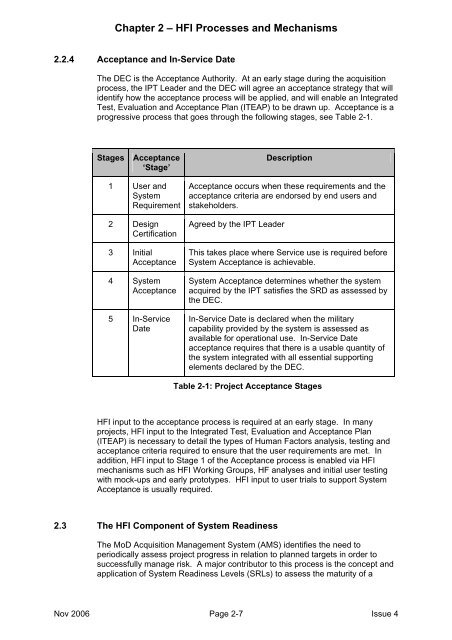MAP-01-010 HFI Management Guide - Human Factors Integration ...
MAP-01-010 HFI Management Guide - Human Factors Integration ...
MAP-01-010 HFI Management Guide - Human Factors Integration ...
You also want an ePaper? Increase the reach of your titles
YUMPU automatically turns print PDFs into web optimized ePapers that Google loves.
Chapter 2 – <strong>HFI</strong> Processes and Mechanisms<br />
2.2.4 Acceptance and In-Service Date<br />
The DEC is the Acceptance Authority. At an early stage during the acquisition<br />
process, the IPT Leader and the DEC will agree an acceptance strategy that will<br />
identify how the acceptance process will be applied, and will enable an Integrated<br />
Test, Evaluation and Acceptance Plan (ITEAP) to be drawn up. Acceptance is a<br />
progressive process that goes through the following stages, see Table 2-1.<br />
Stages<br />
Acceptance<br />
‘Stage’<br />
Description<br />
1 User and<br />
System<br />
Requirement<br />
2 Design<br />
Certification<br />
3 Initial<br />
Acceptance<br />
4 System<br />
Acceptance<br />
5 In-Service<br />
Date<br />
Acceptance occurs when these requirements and the<br />
acceptance criteria are endorsed by end users and<br />
stakeholders.<br />
Agreed by the IPT Leader<br />
This takes place where Service use is required before<br />
System Acceptance is achievable.<br />
System Acceptance determines whether the system<br />
acquired by the IPT satisfies the SRD as assessed by<br />
the DEC.<br />
In-Service Date is declared when the military<br />
capability provided by the system is assessed as<br />
available for operational use. In-Service Date<br />
acceptance requires that there is a usable quantity of<br />
the system integrated with all essential supporting<br />
elements declared by the DEC.<br />
Table 2-1: Project Acceptance Stages<br />
<strong>HFI</strong> input to the acceptance process is required at an early stage. In many<br />
projects, <strong>HFI</strong> input to the Integrated Test, Evaluation and Acceptance Plan<br />
(ITEAP) is necessary to detail the types of <strong>Human</strong> <strong>Factors</strong> analysis, testing and<br />
acceptance criteria required to ensure that the user requirements are met. In<br />
addition, <strong>HFI</strong> input to Stage 1 of the Acceptance process is enabled via <strong>HFI</strong><br />
mechanisms such as <strong>HFI</strong> Working Groups, HF analyses and initial user testing<br />
with mock-ups and early prototypes. <strong>HFI</strong> input to user trials to support System<br />
Acceptance is usually required.<br />
2.3 The <strong>HFI</strong> Component of System Readiness<br />
The MoD Acquisition <strong>Management</strong> System (AMS) identifies the need to<br />
periodically assess project progress in relation to planned targets in order to<br />
successfully manage risk. A major contributor to this process is the concept and<br />
application of System Readiness Levels (SRLs) to assess the maturity of a<br />
Nov 2006 Page 2-7 Issue 4
















